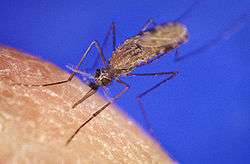Anopheles gambiae
| Anopheles gambiae | |
|---|---|
 | |
| Scientific classification | |
| Kingdom: | Animalia |
| Phylum: | Arthropoda |
| Class: | Insecta |
| Order: | Diptera |
| Family: | Culicidae |
| Subfamily: | Anophelinae |
| Genus: | Anopheles |
| Species: | A. gambiae |
| Binomial name | |
| Anopheles gambiae Giles 1902[1] | |

Anopheles gambiae is a complex of at least seven morphologically indistinguishable species of mosquitoes in the genus Anopheles. This complex was recognised in the 1960s and includes the most important vectors of malaria in sub-Saharan Africa particularly of the most dangerous malaria parasite, Plasmodium falciparum.[2] It is one of the most efficient malaria vectors known.
This species complex consists of:[3]
- Anopheles arabiensis
- Anopheles bwambae
- Anopheles merus
- Anopheles melas
- Anopheles quadriannulatus
- Anopheles gambiae sensu stricto
Despite being morphologically indistinguishable, individual species of Anopheles gambiae complex exhibit different behavioural traits. For example, the Anopheles quadriannulatus is generally considered to be zoophilic (taking its blood meal from animals), whereas Anopheles gambiae sensu stricto is generally anthropophilic (taking its blood meal from humans). Identification to the individual species level using the molecular methods of Scott et al. (1993)[4] can have important implications in subsequent control measures.
Recently a new cryptic subgroup - the Goundry subgroup- of Anopheles gambiae sensu stricto has been described.[5]
Anopheles gambiae in the strict sense
An. gambiae s.s. has been discovered to be currently in a state of diverging into two different species — the Mopti (M) and Savannah (S) strains — though as of 2007, the two strains are still considered to be a single species. The An. gambiae s.s. genome has been sequenced three times, once for the M strain, once for the S strain, and once for a hybrid strain.[6][7] Currently, ~90 miRNA have been predicted in the literature (38 miRNA officially listed in miRBase) for An. gambiae s.s. based upon conserved sequences to miRNA found in Drosophila.
The mechanism of species recognition appears to be sounds emitted by the wings and identified by Johnston's organ.[8]
Historical note
An. gambiense invaded northeastern Brazil in 1930, which led to a malaria epidemic in 1938/1939.[9] The Brazilian government assisted by the Rockefeller Foundation in a programme spearheaded by Fred Soper eradicated these mosquitoes from this area. This effort was modeled on the earlier success in eradication of Aedes aegypti as part of the yellow fever control program. The exact species involved in this epidemic has been identified as An. arabiensis.[10]
References
- ↑ Giles, G.M. (1902). A handbook of the gnats or mosquitoes giving the anatomy and life history of the Culicidae together with descriptions of all species noticed up to the present date. John Bale, Sons & Danielsson, Limited. London, United Kingdom. 530pp
- ↑ "Anopheles gambiae complex". Walter Reed Army Institute of Research.
- ↑ Besansky NJ, Powell JR, Caccone A, Hamm DM, Scott JA, Collins FH (July 1994). "Molecular phylogeny of the Anopheles gambiae complex suggests genetic introgression between principal malaria vectors". Proc. Natl. Acad. Sci. U.S.A. 91 (15): 6885–8. doi:10.1073/pnas.91.15.6885. PMC 44302. PMID 8041714.
Wilkins EE, Howell PI, Benedict MQ (2006). "IMP PCR primers detect single nucleotide polymorphisms for Anopheles gambiae species identification, Mopti and Savanna rDNA types, and resistance to dieldrin in Anopheles arabiensis". Malar. J. 5 (1): 125. doi:10.1186/1475-2875-5-125. PMC 1769388. PMID 17177993. - ↑ C. Fanello, F. Santolamazza & A. Della Torre (2002). "Simultaneous identification of species and molecular forms of the Anopheles gambiae complex by PCR-RFLP". Medical and Veterinary Entomology 16 (4): 461–4. doi:10.1046/j.1365-2915.2002.00393.x. PMID 12510902.
- ↑ Yakob L (2011) Epidemiological consequences of a newly discovered cryptic subgroup of Anopheles gambiae.Biol Lett
- ↑ "Anopheles gambiae: First genome of a vector for a parasitic disease". Genoscope.
- ↑ Lawniczak, M. K.; et al. (Oct 22, 2010). "Widespread divergence between incipient Anopheles gambiae species revealed by whole genome sequences.". Science 330 (6003): 512–4. doi:10.1126/science.1195755. PMC 3674514. PMID 20966253.
- ↑ Pennetier C, Warren B, Dabiré KR, Russell IJ, Gibson G (2009) "Singing on the wing" as a mechanism for species recognition in the malarial mosquito Anopheles gambiae. Curr. Biol.
- ↑ Killeen GF (October 2003). "Following in Soper's footsteps: northeast Brazil 63 years after eradication of Anopheles gambiae". Lancet Infect Dis 3 (10): 663–6. doi:10.1016/S1473-3099(03)00776-X. PMID 14522266.
- ↑ Parmakelis A, Russello MA, Caccone A; et al. (January 2008). "Historical analysis of a near disaster: Anopheles gambiae in Brazil". Am. J. Trop. Med. Hyg. 78 (1): 176–8. PMID 18187802.
External links
- "Anopheles gambiae". VectorBase.
- "Anopheles gambiae". MetaPathogen.
- DiArk